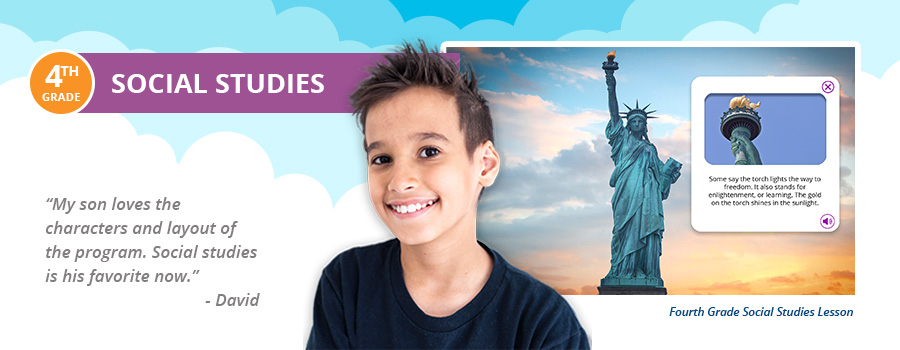Fourth Grade Social Studies Homeschool Curriculum
Time4Learning’s Fourth Grade Social Studies course takes students on a virtual road trip around the United States. The curriculum supports a full year of thoughtful inquiry about regions within the country and targets a specific state within each region, using questions to spark curiosity. This method guides instruction, offers opportunities for exploration, and provides challenging and enriching content. It also promotes knowledge and ideas applicable to real-world settings to actively engage students as citizens. Within the inquiry-based instructional model, lessons will include topics centered around the disciplines of civics, history, geography, and economics.
What Do Fourth Graders Learn in Social Studies?
Your fourth grader will continue to build a foundation in geography, economics, civics and history this year. In addition to focusing in on the history of one state in each region of the United States, the, curriculum will cover:
- Geography of North America
- European Exploration
- First Cultures of the Americas
- U.S. Civics
- Economics
Learn more about Time4Learning’s fourth grade social studies scope and sequence below.
Fourth Grade Social Studies Objectives
By the time they reach fourth grade, students are usually strong readers who have developed the skills for seeing patterns in history and current events. This growth prepares them for reading longer and more in-depth historical narratives and for recognizing how ancient, past, and current events are often tied together.
A standards-based program will target goals like:
- Becoming an active citizen
- Thinking critically
- Using technology to research and report
- Reading and understanding maps
- Using timelines to recognize patterns within chronological sequences
- Interpreting charts, graphs, and tables
- Analyzing primary sources
Don’t forget to look for opportunities to enhance your fourth grader’s social studies skills by incorporating unit studies to help you supplement your lessons. As well, making sure to include field trips into your schedule will boost your child’s learning not only in social studies but across other subjects as well.
Time4Learning’s Fourth Grade Social Studies Lessons
Students will explain that locations on Earth have unique characteristics that make them different from others.
Students will explain the importance of asking questions and organizing their learning.
Students will identify the five themes of geography and explain how maps provide information about them. This will help them answer the chapter’s compelling question.
Students will use maps to review map skills and learn about locations in North America. This will help them answer the lesson’s supporting question.
Students will describe the physical features of places in North America and explain how people interact with the environment. This will help them answer the lesson’s supporting question.
Students will describe the physical features of places in North America and explain how people interact with the environment. This will help them answer the lesson’s supporting question.
Students will review their KWL and use the evidence they’ve gathered to complete a final task related to the chapter’s compelling question. They will also answer multiple choice questions to check their understanding of the material covered within the chapter.
Students are given an opportunity to extend their learning by completing additional activities related to the topics of the chapter.
Students will explain that evidence can be used as clues to help understand or prove something. This will help them answer the chapter’s compelling question.
Students will explain the importance of preserving historic sites so archaeologists can find and use artifacts as new evidence to change our understanding of the past. This will help them answer the lesson’s supporting question.
Students will describe what we know about ancient peoples based on where they lived, how they built homes, and the materials they used. This will help them answer the lesson’s supporting question.
Students will explain what evidence tells us about the first large societies of North America and the innovations they developed. This will help them answer the lesson’s supporting question.
Students will review their KWL and use the evidence they’ve gathered to complete a final task related to the chapter’s compelling question. They will also answer multiple choice questions to check their understanding of the material covered within the chapter.
Students are given an opportunity to extend their learning by completing additional activities related to the topics of the chapter.
Students will describe the hardships and dangers the European explorers experienced while navigating unknown areas. This will help them answer the chapter’s compelling question.
Students will explain why European explorers wanted to travel to the east. They will also identify how technology made travel easier. This will help them answer the lesson’s supporting question.
Students will describe the outcomes of early explorers’ journeys and how they led to further exploration. This will help them answer the lesson’s supporting question.
Students will identify patterns of European settlement and describe how the settlers lived. They will also explain the positive and negative effects of European exploration, including those on Indigenous peoples. This will help them answer the lesson’s supporting question.
Students will review their KWL and use the evidence they’ve gathered to complete a final task related to the chapter’s compelling question. They will also answer multiple choice questions to check their understanding of the material covered within the chapter.
Students are given an opportunity to extend their learning by completing additional activities related to the topics of the chapter.
Students will use a map to identify the five regions of the United States. They will also explain why people move from one place to another. This will help them answer the chapter’s compelling question.
Students will use a map to locate the states and identify unique physical features within the Northeast. This will help them answer the lesson’s supporting question.
Students will identify some reasons people came to the Northeast long ago. They will also compare life in the Northeast long ago to life there today. This will help them answer the lesson’s supporting question.
Students will use maps to compare population in cities. They will also identify a cause and effect relationship between industrialization and migration. This will help them answer the lesson’s supporting question.
Students will identify some reasons people move into or out of the Northeast and explain the benefits and costs of moving. They will also identify patterns in migration decisions in the Northeast today. This will help them answer the lesson’s supporting question.
Students will review their KWL and use the evidence they’ve gathered to complete a final task related to the chapter’s compelling question. They will also answer multiple choice questions to check their understanding of the material covered within the chapter.
Students are given an opportunity to extend their learning by completing additional activities related to the topics of the chapter.
Students will explore hidden meanings of some places. This will help them answer the chapter’s compelling question.
Students will use a map to identify physical features of New York State and match the names with their meanings or origins. This will help them answer the lesson’s supporting question.
Students will use maps to identify areas where people of different cultures have lived in New York. They will also explain the importance of meanings behind names of well-known places and geographic features within those areas. This will help them answer the lesson’s supporting question.
Students will use a map to identify the location of the five boroughs of New York City and explain how their names tell us about people who have lived there. They will also explain how the original meanings behind the names of places and features have changed over time. This will help them answer the lesson’s supporting question.
Students will review their KWL and use the evidence they’ve gathered to complete a final task related to the chapter’s compelling question. They will also answer multiple choice questions to check their understanding of the material covered within the chapter.
Students are given an opportunity to extend their learning by completing additional activities related to the topics of the chapter.
Students will explore the unique geographic, historical, and cultural characteristics of the Southeast region of the United States.
Students will explain how geography and climate affect life for people in the Southeast. This will help them answer the lesson’s supporting question.
Students will identify those who have settled in the Southeast and the circumstances surrounding their settlement. They will also explain settlers’ influences on the region. This will help them answer the lesson’s supporting question.
Students will describe cultural aspects that are unique to the Southeast in the areas of music, art, and food. This will help them answer the lesson’s supporting question.
Students will review their KWL and use the evidence they’ve gathered to complete a final task related to the chapter’s compelling question. They will also answer multiple choice questions to check their understanding of the material covered within the chapter.
Students are given an opportunity to extend their learning by completing additional activities related to the topics of the chapter.
Students will explore natural disasters and safety measures that can be put in place to prepare for them. This will help them answer the chapter’s compelling question.
Students will explore natural disasters and the dangers and destruction they can cause. This will help them answer the lesson’s supporting question.
Students will explore geographic characteristics that make some places vulnerable to certain natural disasters. This will help them answer the lesson’s supporting question.
Students will identify preparations that can be put into place before, during, and after natural disasters. This will help them answer the lesson’s supporting question.
Students will review their KWL and use the evidence they’ve gathered to complete a final task related to the chapter’s compelling question. They will also answer multiple choice questions to check their understanding of the material covered within the chapter.
Students are given an opportunity to extend their learning by completing additional activities related to the topics of the chapter.
Students will describe the laws that led to the growth of the Midwest. This will help them answer the chapter’s compelling question.
Students will explain how geography has influenced the agriculture and industry of the Midwest. This will help them answer the lesson’s supporting question.
Students will describe the factors that led to expansion into the Midwest. This will help them answer the lesson’s supporting question.
Students will explain how industrial and agricultural growth has affected the Midwest. This will help them answer the lesson’s supporting question.
Students will review their KWL and use the evidence they’ve gathered to complete a final task related to the chapter’s compelling question. They will also answer multiple choice questions to check their understanding of the material covered within the chapter.
Students are given an opportunity to extend their learning by completing additional activities related to the topics of the chapter.
Students will describe the characteristics of Illinois and explain the factors that have influenced those characteristics. This will help them answer the chapter’s compelling question.
Students will explain how geography has influenced the agriculture and industry of the Midwest. This will help them answer the lesson’s supporting question.
Students will explain factors that have led to the growth of Illinois and the effects of that growth. This will help them answer the lesson’s supporting question.
Students will explain the effects that being a hub has had on Illinois. This will help them answer the lesson’s supporting question.
Students will review their KWL and use the evidence they’ve gathered to complete a final task related to the chapter’s compelling question. They will also answer multiple choice questions to check their understanding of the material covered within the chapter.
Students are given an opportunity to extend their learning by completing additional activities related to the topics of the chapter.
Students will investigate the physical geography of the states in the Southwest. This will help them answer the chapter’s compelling question.
Students will investigate the landforms and bodies of water in the Southwest. This will help them answer the lesson’s supporting question.
Students will explain how travel and settlement have been impacted by the availability of water in the Southwest. This will help them answer the lesson’s supporting question.
Students will describe ways in which people have managed the water supply in the Southwest. This will help them answer the lesson’s supporting question.
Students will review their KWL and use the evidence they’ve gathered to complete a final task related to the chapter’s compelling question. They will also answer multiple choice questions to check their understanding of the material covered within the chapter.
Students are given an opportunity to extend their learning by completing additional activities related to the topics of the chapter.
Students will investigate the characteristics and achievements of specific Texas leaders and trace the passing of leadership from one nation to another. This will help them answer the chapter’s compelling question.
Students will investigate the regions of Texas and the natural resources found in each. This will help them answer the lesson’s supporting question.
Students will describe the effects that Spanish and Mexican control had on Texas. This will help them answer the lesson’s supporting question.
Students will describe the effects that becoming a republic had on Texas and the events that led to its founding. This will help them answer the lesson’s supporting question.
Students will describe the effects of statehood on Texas. This will help them answer the lesson’s supporting question.
Students will review their KWL and use the evidence they’ve gathered to complete a final task related to the chapter’s compelling question. They will also answer multiple choice questions to check their understanding of the material covered within the chapter.
Students are given an opportunity to extend their learning by completing additional activities related to the topics of the chapter.
Students will examine how geographic challenges in the West have led to government imposed regulations. This will help them answer the chapter’s compelling question.
Who Has Controlled the Land in the West Over Time?
Students will identify physical features and natural resources in the West and their related challenges. This will help them answer the lesson’s supporting question.
Students will explain the ways that people and companies use government lands. They will also describe the balance between helping the economy and protecting the environment when using government lands. This will help them answer the lesson’s supporting question.
Students will review their KWL and use the evidence they’ve gathered to complete a final task related to the chapter’s compelling question. They will also answer multiple choice questions to check their understanding of the material covered within the chapter.
Students are given an opportunity to extend their learning by completing additional activities related to the topics of the chapter.
Students will be introduced to two periods of economic growth that shaped California–the Gold Rush and the tech boom. This will help them answer the chapter’s compelling question.
Students will learn about the regions of California and the early days of the Gold Rush. This will help them answer the lesson’s supporting question.
Students will explore the impact of population growth on California by learning about economic factors during the Gold Rush, the transcontinental railroad, and population growth over time. This will help them answer the lesson’s supporting question.
Students will explore the effects and impact of the tech boom and describe how the innovation of the tech boom has changed how people interact today. This will help them answer the lesson’s supporting question.
Students will review their KWL and use the evidence they’ve gathered to complete a final task related to the chapter’s compelling question. They will also answer multiple choice questions to check their understanding of the material covered within the chapter.
Students are given an opportunity to extend their learning by completing additional activities related to the topics of the chapter.
Students will begin by recording things they know and want to know about different states. This will help them decide which state or states to begin to research.
Students will collect information for their report. They will learn how to identify and cite reliable print or internet sources and make a list of sources they will use for their report. They will make notes from the sources they select and group information by topic.
Students will draft, revise, edit, and publish their report. A final checklist for students will help them catch aspects that need polishing. Parents may use the checklist to grade the report.
Students will design a presentation to share information about the state they chose with family or homeschool friends. They will prepare visuals and speaker notes, and practice good presentation habits to make a presentation that shines.
Why Choose Time4Learning’s 4th-Grade Social Studies Curriculum?
In fourth grade, it is important that your students don’t lose motivation and love of learning in any subject. Time4Learning presents lessons in a fun way that lets students progress at their own pace so they don’t become frustrated with concepts that may take them longer to understand.
The popularity of Time4Learning among homeschool families stems in large part from its flexibility. Parents are able to pick and choose the lessons, topics, and activities that help them achieve their overall goals.
Learn more about our online fourth grade curriculum, designed to help your child learn and master their fundamental concepts.







